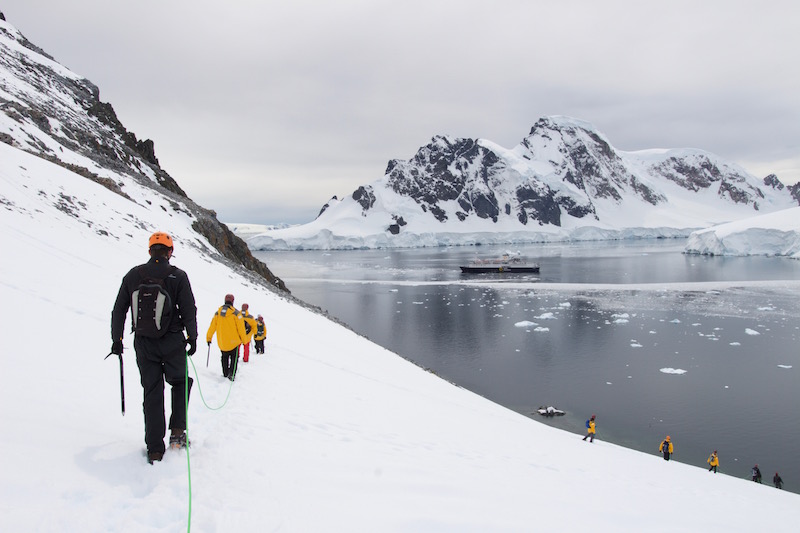You don’t have to be Sir Ranulph Fiennes to embark on an expedition to Antarctica. Maxwell Roche gives a glimpse into the joys that a polar cruise can deliver…
As I cracked a second vial of Ondansetron (a strong anti sea-sickness solution) into my morning orange juice, I braced myself for the next gut-wrangling roll. Life aboard the MS Ocean Endeavour, bound for the Antarctica, had been, shall we say, ‘internally challenging’ thus far. ‘Drake Passage’ (said in a low ominous voice), the notorious 500-mile stretch of ocean that separates Antarctica from the southernmost tip of South America, frothed outside my rain-lashed cabin porthole. Instead of waiting like a pig in a barrel for the drugs to kick in, I decided to take my mind off the nauseating motion in the ocean, don my sports gear, and visit the onboard gym.
I couldn’t help but feel slightly ridiculous as I slipped on my trainers, jogged down the swaying corridor and skipped up the stairs to the deck seven spa. I was travelling across the most feared stretch of ocean on the planet, to the wildest, most extreme, most remote destination there is, a place that has claimed the lives of many venturesome travellers before me and here I was in skimpy nylon running shorts, after a full English breakfast, on my way for a light gym session, followed by a massage, sauna and spa.
Clearly a lot had changed in the one-hundred-and-four years that have elapsed since Shackleton’s ship Endurance was crushed and sunk by pack ice in the Weddell Sea 50 miles off our port bow. Feeling distinctly wimpish in comparison to my heroic predecessors, I abruptly decided to pass up the luxuries, pull a U-turn, change into my wet weather gear and start going about my voyage in the old fashioned way – on deck, facing toward the grey horizon, crow’s feet ever deepening, squinting to protect my eyeballs from the frigid saline wind.
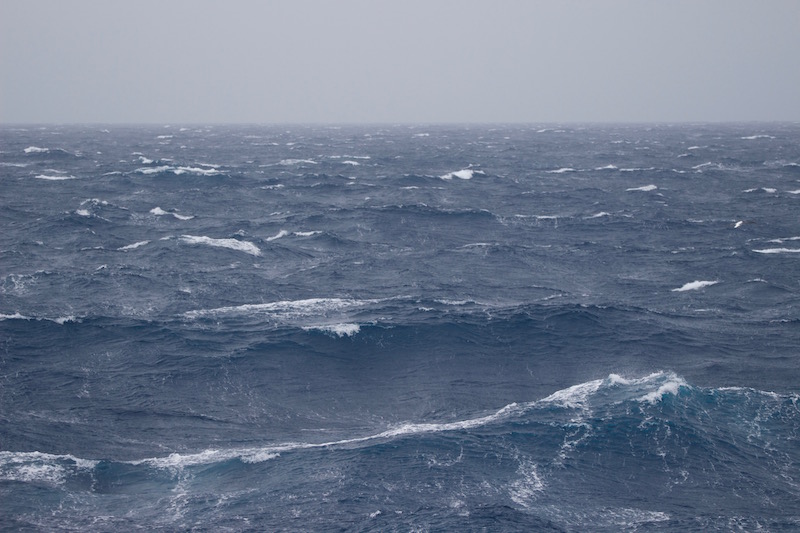
The shrouding mist cleared momentarily to reveal one of the most salient sights I have ever beheld. Using invisible currents and its 11.5-foot razor-tipped wings, a giant wandering albatross glided like a pterodactyl over the ships wake. It skimmed inches above the frothing swells hunting for unsuspecting, surface-dwelling fish. The sleek and monstrous bird then soared up and over the ship mere meters from my nose. “They can spend up to twenty years at sea,” says a bearded gentleman from over my left shoulder, “and they can fly 250,000 miles in a single year”. Dumbfounded by such statistics I groaned and looked back toward the gloom.
Time passed and the bird didn’t reappear. As the fog thickened, and the drizzle turned to sleet, my commitment to the deck wained. Set on beating my retreat, I blew into my palms, ramming them deep into the quilted pockets of my parker. It was then that providence rewarded me with yet another striking and significant sight: my first iceberg. A shocking thing to behold, colossal and rectangular, it emerged in a foreboding fashion from the fog. The berg approached, growing steadily until its sheer vertical walls rising hundreds of meters out of the black and white surf dwarfed the ship. Along with the chap next to me, I squinted in the direction of its jagged zenith, our necks craned in unison.
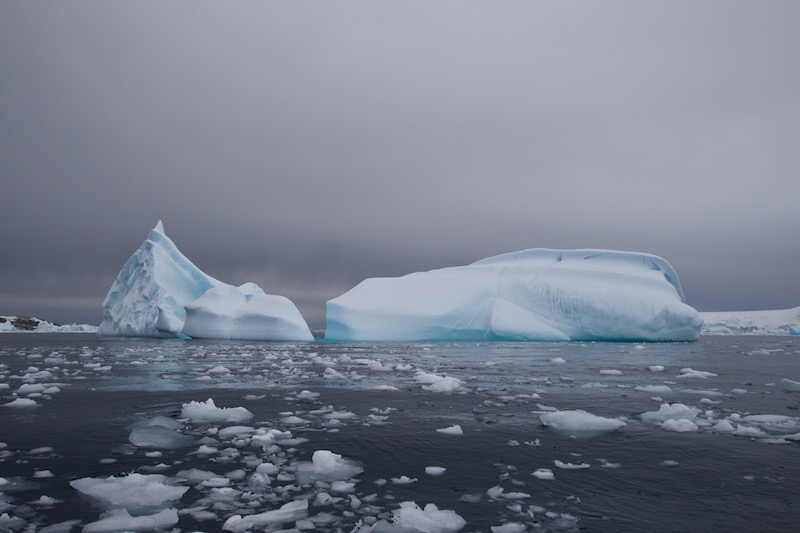
“That’s a tabular iceberg,” he said knowingly. “It’s cracked straight off the Antarctic ice shelf and because it’s so massive, it’s floated 400 miles north without melting”. I groaned with surprise for the second time in as many minutes. The bearded gent then went on to introduce himself as Michael Hambrey, resident glaciologist aboard the MS Ocean Endeavour. I looked back toward the berg, unsettlingly proximate as it passed, and began to worry about the strength of the captain’s binoculars.
Beyond the bow of the Zodiac dingy, above the cobble and black ash beach loomed Brown Bluff, a Basalt Tuya (a rare flat-topped, steep-sided volcano formed when lava erupts form below a glacier). As we neared the shore I was struck, not by the size of Brown Bluff but by its colour. There are colours I expected to see in Antarctica: white for one, certainly blue, but not brown. The day was as still as a day could be; downy clouds and an electric sky reflected in the oceans mirrored surface which scrolled like an endless tapestry beneath our boat. Icebergs formed by ancient glaciers were scattered all around, some the size of coffee tables and some the size of buses.
The bergs, so dense and devoid of air, pierced the molten glass water and absorbed the entire spectrum of light. The only colour that escaped their avaricious walls was high-energy, brilliant blue. The blue faded to black along their perimeters, suggesting a vastness hidden below. As I pondered the vastness of the bergs and the vastness of such a place in general, the Zodiac motor died and we slid up the basalt beach.
We were a team 12 strong, and the order of business for the day was not simply to explore the coastline, but to mountaineer high up into the Antarctic hills, an activity reserved for athletic and adventurously inclined explorers looking to gain a unique perspective.
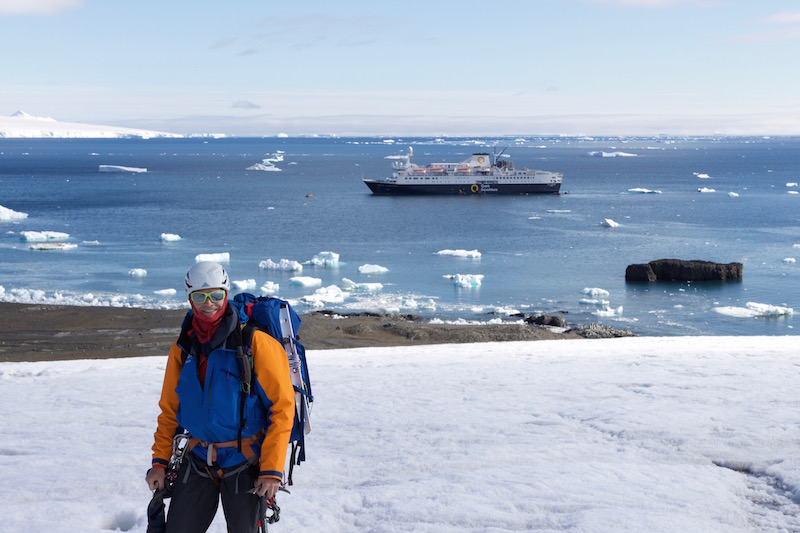
Our excursion was being led by Pete Cammel, a jolly Kiwi mountain guide of 40 years and ex-president of the New Zealand Alpine Club; Pete has many coveted summits to his name, Mount Denali and Mount Everest among them. Needless to say we were in good hands, one of which extended to me as I stepped down from the Zodiac. “Welcome to Antarctica,” said Pete with a grin once we were all safely on shore, “population zero”. I looked down and admired my footprints, the tread of my insulated wellingtons clearly stamped into the mythical Seventh Continent. Before we could begin our climb Pete issued us each with a set of crampons and an ice axe (briefings on the proper use of which had been carried out during our Drake Passage crossing).
Bent double in a semicircle, we begun the tactical task of donning crampons with cold fingers and a chorus of huffs and puffs ensued. Huffs and puffs quite suddenly turned to oohs and aahs as we are met by an unexpected surprise. Whilst we’d been concentrating on our boots, a solitary Adelie penguin had sauntered its way into our circle. Pete motioned for us to move aside and let the little flippered fella pass. After we’d all taken a step back the penguin, seemingly in thanks, put its head back, let out a hoot, and waddled off toward the water’s edge.
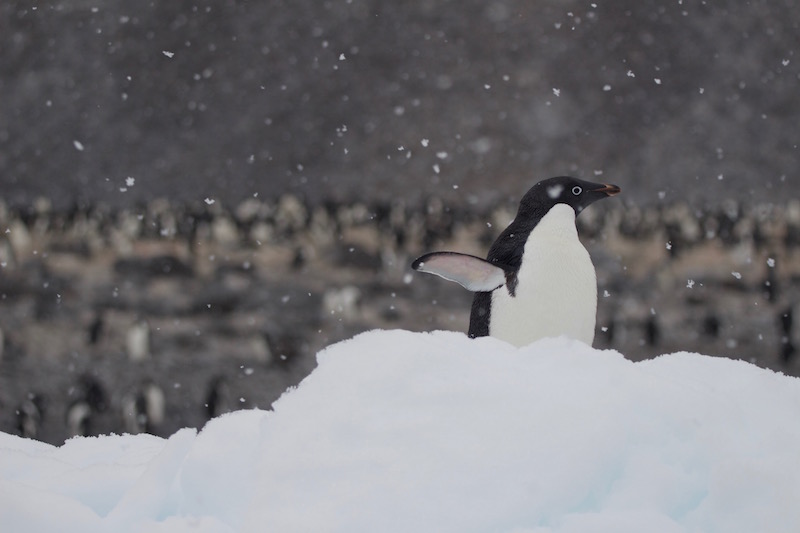
Before long hundreds of Adelie penguins (one of the two penguin species indigenous to Antarctica) emerged from behind a giant lump of sea ice and followed in the footsteps of their audacious leader. Pete explained the penguin’s lack of concern was due to the fact that they have no land predators on the continent. They’ve also had little or no contact with humans (except in 1914 when Shackleton ate a couple), giving them no reason to treat us like anything other than a curious inconvenience. What we weren’t allowed to do, Pete stressed, was interrupt their natural behaviour (i.e. get in their way). I thought back on the scornful look given to us by the first penguin, and decided he or she, after a lifetime of smooth, unhampered waddling was perfectly entitled to be a bit miffed when suddenly impeded by a group of 12 goggle-eyed tourists.
Delighted to have come face-to-face with the emblematic and comical little creatures so early in our trip we lined up single file and begin our journey skyward. The going was easy at first; even the complete novices amongst us were getting to grips with the crampons and their initial awkwardness. Pete’s jolly tones up ahead were soon accompanied by a chorus of heavy breathing as the terrain steepens.
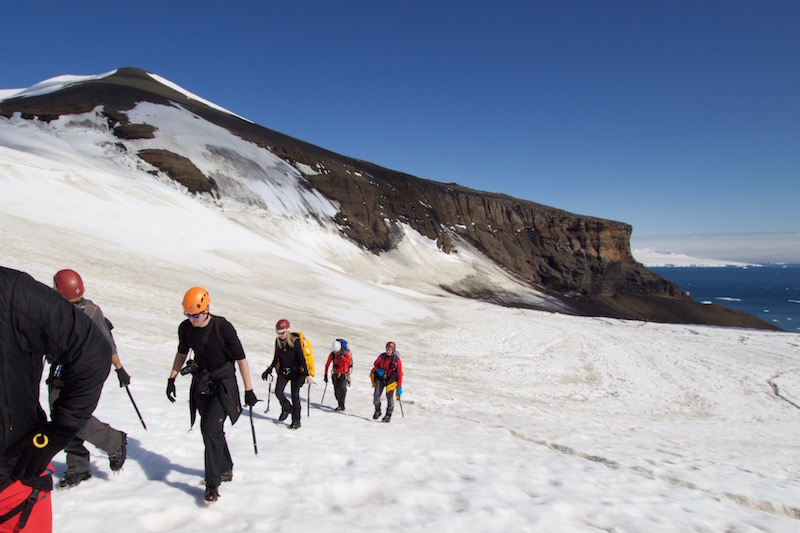
After an hour or so we mustered. Pete explained that we were soon to be moving onto glaciated terrain and would need to travel ‘alpine style’. He helped us into harnesses, and connected us into teams of six using two long ropes. Pete led and we were advised to follow in his footsteps in order to avoid the many lethal crevasses waiting to swallow us up.
Before we recommenced our journey skyward, I took a moment to gaze over my shoulder at the vista. I took an immense breath, trying for the first time to really digest where I was. Antarctica offers very little in the way of smell, just an underlying threat of cold that caused my nostril hairs to crackle. The view, however, was more than adequate compensation for the disappointing lack of odours. Except for the MS Endeavour, anchored way out in the bay, and our slender trail of footprints cascading toward the shore, not a single trace of human existence was visible.
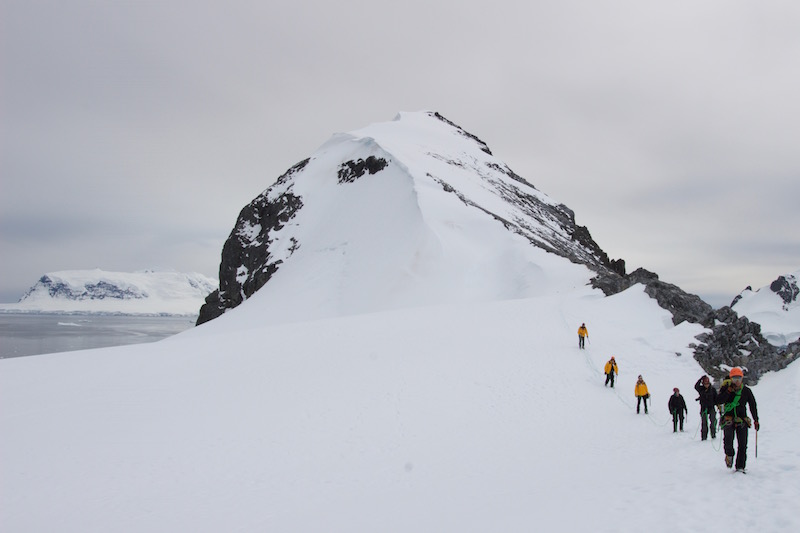
This singularity is perhaps the most powerful Antarctica has to offer; the opportunity for a person to stand and look out upon a landscape totally untouched by, and devoid of, his/her own species. Travellers can expect to experience something that has no equivalent, except perhaps to the experience had by Neil and Buzz in 1969 when they landed on the moon.
“Brace, brace, brace” yelled Pete from up ahead. We had been hiking for two hours and were approaching the final summit. Unfortunately for one of our party, Ian, an army captain from Highgate, the ground had indeed opened up. Ian looked down at his crampons swinging freely, starkly contrasted by the azure glacial blue at the bottom of the crevasse. Sat in the snow around him, our heels dug in firmly, leaning back to secure the rope, we could only see the top of his head. An Afghanistan veteran, and lover of danger, Ian surprised us with a grin as we pulled him to safety. “That’s why we rope up,” said Pete as we muster on some solid ground. “I think it’s time we descend”.
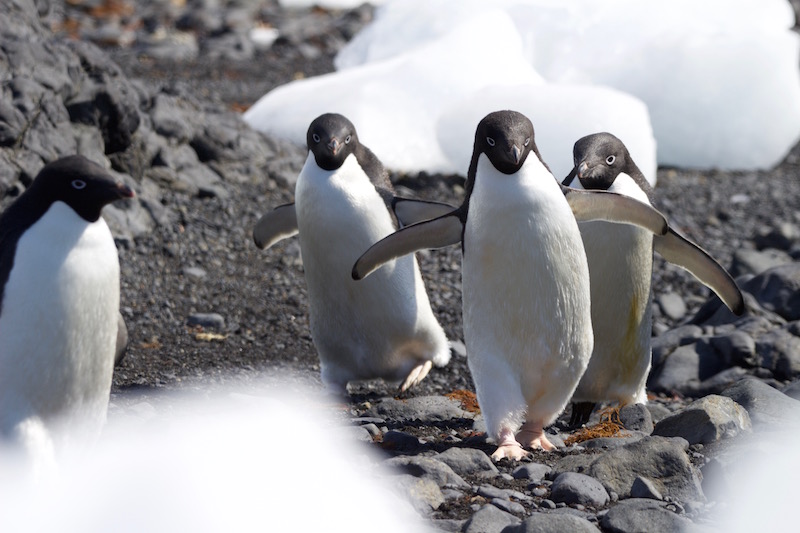
During our downhill march back to the penguin colony and our Zodiac at the base of the Bluff, Pete bewitched us with calamitous crevasse anecdotes befitting of a man who’s spent his life amid snowy and severe topography. Back aboard the Endeavour, showered, watered and with a four-course meal imminent, Ian and I sat with Pete and plied him with pints, angling for further tales of mountain heroism and the mighty Mount Everest.
As I unrolled the bivvy bag, and laid it down carefully in my freshly dug coffin-shaped ice trench, a chill ran through me. To celebrate our last night in Antarctica we’d decided to relinquish the cosy confines of the ship and camp out ‘on the ice’. Instead of a traditional tent, we had elected to snooze with nothing between us and the elements except a fleece-lined waterproof bag. With only two hours of semi-darkness in December (Antarctic midsummer), and an expected overnight temperature of –10C, I wasn’t entirely sure how much sleep I’d be getting.
Before we turned in Ian, Trudy and I pulled up a pew down by the beach at Dorian Bay. We poked fun at the 95-stone crabeater seals as they rolled around clumsily with their bellies full of fish, yawning and groaning. “Ironically, they don’t eat crabs,” said Trudy, as Ian handed around a hipflask of 16-year-old Scotch. After a warming draft we parted ways and disappeared off to our respective ice coffins.
I laid awake a short while with just my eyes and nose protruding from the bivvy, listening once again to the sounds of ‘Antarctic Thunder’. As the booms and cracks echoed across the landscape I attempted to slow time. With our trip nearly at an end, this moment, alone in the half-light amid the unfathomable wilderness, was a moment so special there was nothing to do but savour it.
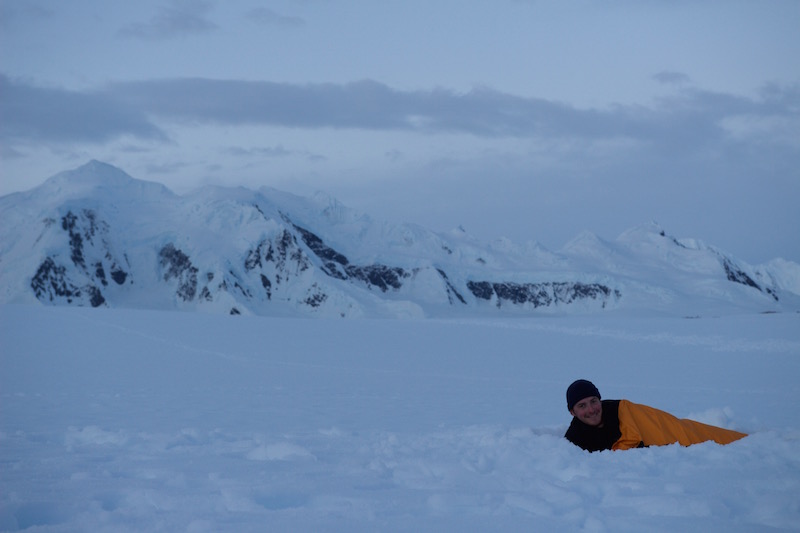
“Wake up Sleeping Beauty!” shouted Ian from the water’s edge. Bewildered by the noise, I peered above the wall of my ice trench only to be blinded by the newly risen sun glinting off fresh snow. When my vision returned it revealed a completely abandoned campsite. Ian could just be made out waving energetically from the last remaining Zodiac readying for departure on the beach. Contrary to all expectation, I had slept as still as a prehistoric stone for a full eight hours. Annoyed to be so rudely awakened and rushed out from within my perfect cocoon, I packed up my frozen belongings and charged across the snow to meet the others.
Once all were on board, I let out an audible sigh; our Zodiac driver, Marine biologist Jimmy Zakreski, shrugged his shoulders and raised his eyebrows at me knowingly. As we motored below the imposing ice-strengthened bow of the MS Endeavour for the very last time Jimmy’s radio crackled. “They’ve spotted some humpbacks,” he announced. “It’s going to be a little rough, hang on!” Before we had a chance to ask questions he cranked the motor and pointed us in the direction of the open ocean.
“There she blows!” yelled Jimmy, as the whale spout blasted visibly on the horizon. The next spout was so close the savoury mist, caught by the gathering wind, spattered across our faces. “OK,” said Jimmy cutting the motor, “now we let them come to us”. Some minutes passed without a sighting. Many of us who had stood in anticipation took our seats once again, convinced that the whale, alarmed by our presence, had vanished into the deep.
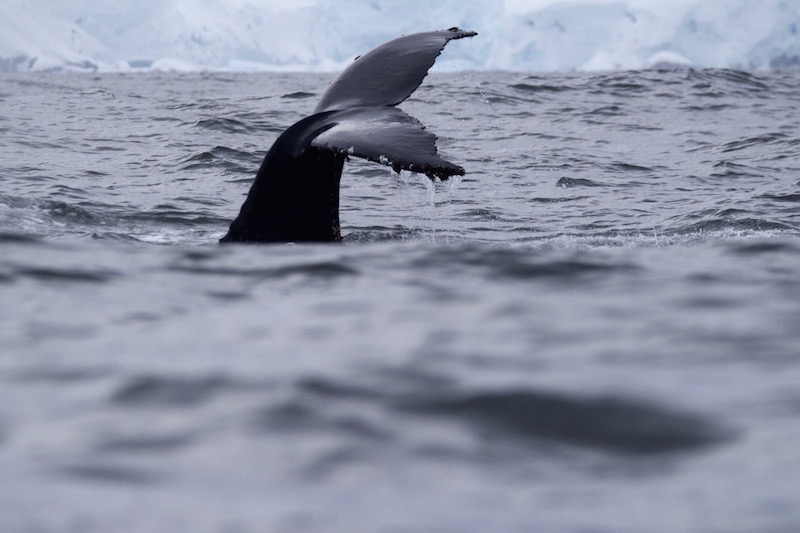
“HHHHhhhhhhhoooooooogh!” went the 49-foot, 36-tonne humpback whale as she surfaced within touching distance of the Zodiac, her calf close behind her. The noise that erupted from her football-sized blowhole was so loud and so deep that it shook my very bones. Testament to the cavernous capacity of the lungs that had created such a note, I began to wonder whether the pipe organ at St Paul’s Cathedral could rival it.
As the mother and her calf sunk slowly back below the surface, and the vast quantity of water that has been displaced rushed to fill the void, I stared across at my shipmates still cowering in the bottom of the boat, Jimmy included. “Woooooooohooooo!” screamed Jimmy jumping bolt upright. “I have never been that close to a humpback!”. Jimmy simmered slowly and settled sufficiently to track the whales a while longer; we were treated to countless further spectacular surfacings, but none so stupefying as the first.
How to visit Antarctica
Maxwell travelled to Antarctica with Quark Expeditions, a polar adventure travel company offering expeditions between November and February each year. Trips tend to include all activities such as mountaineering, camping and wildlife spotting.
What to take to Antarctica
It should come as no surprise that you’ll need cold weather gear. Layering is key, so warm base layers are a must (merino wool offer great warmth and they are naturally anti-microbial) for both top and bottom while you’ll also want several warm layers on top of this (think fleece and technical mid layers). Sunglasses with UV protection shouldn’t be overlooked, nor should hats, gloves or scarves, and depending on the tour company, you may need a warm winter jacket, sturdy, waterproof walking boots and waterproof trousers.
When to visit Antarctica
Most polar excursions to Antarctica take place between November and early March and you’ll need to plan according to these. Unless you plan to embark on a long, tough and remarkable expedition on your own, you’re going to be limited to going on predetermined tours and dates.


